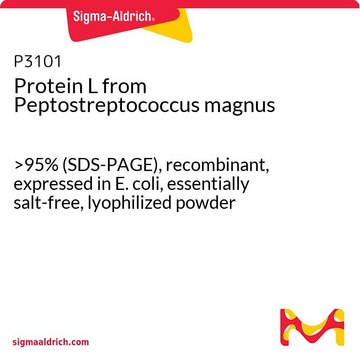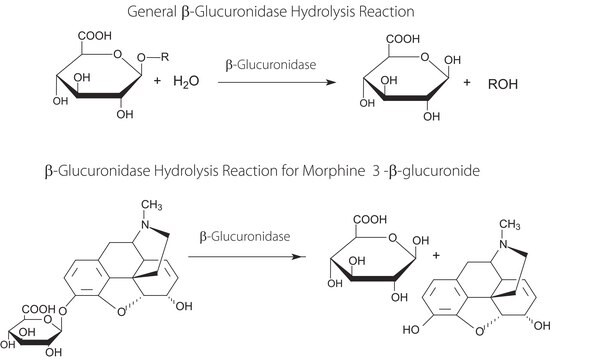F9015
Fluorescamine
≥98% (TLC), powder, used for detection of primary amines
Synonym(s):
4-Phenylspiro-[furan-2(3H),1-phthalan]-3,3′-dione
Sign Into View Organizational & Contract Pricing
All Photos(4)
About This Item
Empirical Formula (Hill Notation):
C17H10O4
CAS Number:
Molecular Weight:
278.26
Beilstein:
921143
EC Number:
MDL number:
UNSPSC Code:
12352204
PubChem Substance ID:
NACRES:
NA.32
Recommended Products
Assay
≥98% (TLC)
form
powder
color
off-white to yellow
mp
153-157 °C (lit.)
solubility
acetone: 50 mg/mL
storage temp.
room temp
SMILES string
O=C1OC2(OC=C(C2=O)c3ccccc3)c4ccccc14
InChI
1S/C17H10O4/c18-15-13(11-6-2-1-3-7-11)10-20-17(15)14-9-5-4-8-12(14)16(19)21-17/h1-10H
InChI key
ZFKJVJIDPQDDFY-UHFFFAOYSA-N
Looking for similar products? Visit Product Comparison Guide
General description
Fluorescamine, a heterocyclic dione, reacts with primary amines, amino acids, peptides, and protein to form a fluorescent product. Excess reagent and its degradation products are non-fluorescent. The fluorescence of a solution containing protein plus fluorescamine is equivalent to the quantity of free amine groups present. This is the basic principle of a fluorescent protein assay. Fluorescamine is used as a derivatizing agent for the identification of various compounds used in the pharmaceutical industry, such as oseltamavir, penicillamine, sulfonamide residues, lisinopril, methotrexate, vigabatrin, and gabapentin.
Application
Fluorescamine has been used as a stain to localize granular proteins on the surface of foxtail millet starch as well as protein in foxtail millet flour through confocal scanning laser microscopy (CSLM). It has also been used for photometric determination of para-aminobenzoic acid.
Non-fluorescent reagent that reacts readily under mild conditions with primary amines in amino acids and peptides to form stable, highly fluorescent compounds. Low background due to hydrolysis. Useful for the fluorometric assay of amino acids, protein, and proteolytic enzymes. Effectively blocks newly generated amino termini in protein sequence analyses.
Storage Class Code
11 - Combustible Solids
WGK
WGK 3
Flash Point(F)
Not applicable
Flash Point(C)
Not applicable
Personal Protective Equipment
dust mask type N95 (US), Eyeshields, Gloves
Choose from one of the most recent versions:
Already Own This Product?
Find documentation for the products that you have recently purchased in the Document Library.
Customers Also Viewed
S Udenfriend et al.
Science (New York, N.Y.), 178(4063), 871-872 (1972-11-24)
Fluorescamine is a new reagent for the detection of primary amines in the picomole range. Its reaction with amines is almost instantaneous at room temperature in aqueous media. The products are highly fluorescent, whereas the reagent and its degradation products
S Udenfriend et al.
Science (New York, N.Y.), 178(4063), 871-872 (1972-11-24)
Fluorescamine is a new reagent for the detection of primary amines in the picomole range. Its reaction with amines is almost instantaneous at room temperature in aqueous media. The products are highly fluorescent, whereas the reagent and its degradation products
Hai-Teng Li et al.
Food chemistry, 330, 127328-127328 (2020-06-23)
Granular protein is an important structural feature in determining starch digestibility. High-amylose wheat starch (HAWS) with >80% amylose content contains more granular protein than wild-type starch. As analyzed by mass spectrometry-based proteomics, granular-bound starch synthase (GBSS) is the major granular
P C Hollman et al.
The American journal of clinical nutrition, 62(6), 1276-1282 (1995-12-01)
Quercetin is a dietary antioxidant that prevents oxidation of low-density lipoproteins in vitro. Intake of quercetin was inversely associated with coronary heart disease mortality in elderly Dutch men. However, the extent of absorption of quercetin in humans is unclear. The
Wen-Hsien Tsai et al.
Journal of chromatography. A, 1217(49), 7812-7815 (2010-11-04)
A simple sugaring-out assisted liquid-liquid extraction method combined with high-performance liquid-chromatography with fluorescence detection (HPLC-FL) was developed for the extraction and determination of sulfonamides in honey. Sample preparation consisted of acid hydrolysis to release sugar-bound sulfonamides. After derivatization with fluorescamine
Our team of scientists has experience in all areas of research including Life Science, Material Science, Chemical Synthesis, Chromatography, Analytical and many others.
Contact Technical Service







